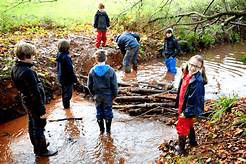24 weeks, two seasons, and two hours each. These schedule criteria are meant to offer enough time to build trust and for self-reflection.
What period of time should Forest school operate their sessions?
Magnifying glass (for observing nature up close), Garden burlap (to make hammocks), Watering cans (to water plants, etc), Baskets (to collect things), Rope, Tarps (in case it rains, shelter-making), Paint, brushes, palettes, Drop cloth (to make maps and/or flags)
What are the materials used to learn?
There is no curriculum, rather learning is a process between the practitioner and student. In Forest School, progress is defined not by the goal but by the process.
What is the teaching approach?
Forest school allows children to care for their own well-being as well as others’. As they learn to care for the environment and natural life around them, students adapt these methods to take care of themselves as well. Other teachings in forest school that promote well-being include self-esteem, emotional regulation, confidence, empathy, trust, and love.
How does the approach connect to well-being?
Trust, Reciprocal Relationships, Freedom
What are the three pillars of forest schools?
Level 3 qualified Forest School Practitioners should know how to carry out site checks and understand the environmental impacts of Forest Schools. They have teaching and practical skills and are trained in first aid. More broadly, practitioners must be self-reflective and re-evaluate themselves often, adapting and changing with experience
Who runs forest schools?
To guide and support the children as they discover and participate in their interests. They are not thought of as experts, rather they continue to learn with the students. They facilitate engagement, ensure safety, and promote community building.
What is the role of a Forest School practitioner/teacher?
This curriculum model developed out of the Waldorf approach, with the first known school being started in Denmark by Ella Flautau in 1952. This model reached Canada in 2007, with the first school being opened just outside Ottawa.
What is the history of the forest school approach?
Children learn that they are all citizens of the natural world
How does the approach connect to belonging?
The process
What is valued more than the outcome?
A natural wooded environment, such as with trees, when possible. This will encourage the use of natural materials and promote appreciation for the natural world
Where do forest school sessions take place?
Repeated visits to the same outdoor space for learning.

What is the learning environment?
The goal of this learning is to support a connection between the Land and the child. It is founded on three pillars: "Trust, Reciprocal Relationship and Freedom."
What is the philosophy of the forest school approach?
Children interact with each other and learn how to respectfully and safely interact with wildlife, including plants, animals, and the land itself.
How does the approach connect to engagement?
2007
What year did Forest Schools come to Canada?
Holistic development, which encompasses emotional, spiritual, intellectual, social, physical, communication, and language development
What do forest schools value the most?
Innately competent, curious, and capable. It encourages them to develop their intrinsic connection with nature and supports their natural risk-taking inclinations.
What is the view of the child?
To promote self-reflection at a young age, foster connections with peers and nature, encourage community building, and create a more sustainable world
What is the goal of the approach?
Children are free to explore themselves in a safe but open environment. Activities are meant to inspire and channel creativity with no final product in mind so that students can work towards personal goals without the pressure of being “right”. Students are encouraged to work together in order to solve problems and learn by doing.
How does the approach connect to expression?
Forest schools promote learner-led learning
Who leads the learning?
Within reason, children should be given opportunities to face risks and learn to overcome them. Aside from physical risk, students can also conquer social and emotional risks. Distinct from risk-averse.
What is risk-aware?
This type of play is an integral part of children’s learning and development that is facilitated by qualified practitioners who provide children with the opportunity to face risks and overcome them.
What is risky play?
Play-based, emergent, and inquiry-driven teaching
What are the types of methods used by this approach?
Students have the opportunity to learn experientially in a self-guided way through emergent learning.
How does the approach connect to engagement?
Forest schools find it important to build reciprocal relationships with these groups, who have been learning from this Land for a long time.
Who are First Nations, Métis, and Inuit?